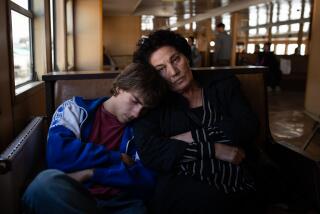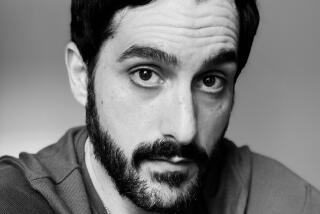Georgians Are About to Give San Diegans a Whirl : Dance: This troupe, part of what is arguably the Soviet Union’s No. 1 cultural export, was the first attraction in the arts festival to sell out, and a performance was added.
SAN DIEGO — Now that the Soviet arts festival is well under way, more and more San Diego audiences are discovering the beauty, power and diversity of treasures from the Soviet Union. From contemporary theater to traditional puppetry--and, of course, the much-ballyhooed Faberge eggs--the Soviet arts are firmly entrenched on San Diego soil.
But Soviet dance, arguably the country’s No. 1 artistic export, has yet to make a full-scale formal debut on a San Diego stage. That welcome event is scheduled for 8 p.m. Wednesday, when the Georgian State National Singing and Dancing Ensemble--an ethnic troupe composed of 87 dancers, singers and musicians representing various regions of Soviet Georgia--bows in at the Spreckels Theatre.
The Georgian dancers will perform nine shows at the Spreckels before the last curtain call Sunday night, as well as the 70-plus performances planned for outreach programs in local schools, colleges, military bases and senior citizen facilities.
Although Georgian folk forms are far less familiar to American audiences than Russian ballet (which, ironically, is not among the art forms included in the festival), the Georgian troupe was the first to sell out in San Diego. In fact, as Tatiana Popova, local liaison for the troupe, noted, “It was sold out at the very beginning, and we had to add three matinees.” A fourth matinee has since been added for 11 a.m. Saturday.
Popova selected the slate of dance offerings on the company’s San Diego program, opting for a mix that would “give people a taste of every style of Georgian dance.”
Because Georgian dance is unique in many ways, most local aficionados will be surprised at what they see, especially the dancing from the mountain regions. Black-booted macho men pounce vigorously on pointe, then crash down to a hard landing on their knees, in sharp contrast to the ethereal beauty of balletic pointe work (performed only by female dancers).
Georgian women, on the other hand, glide gracefully across the floor, hardly moving their feet and looking more like ice skaters than dancers. The sexes never touch, not even when they pair off for the obligatory couples dances.
The Georgians “are the only ones in the world to do male pointe work,” Popova acknowledged. “And they dance only on the soft tips of their boots. The women’s gliding is done by other races, but it reached its pinnacle with the Georgians.”
Georgian men and women dance together, but they are careful to avoid physical contact, she said.
“That is the reason the men wear very long sleeves, so the women can hold the fabric during the dancing. They can never actually touch, and the women can never do anything to attract the men’s attention. The women’s eyes are always looking down.
“The dancing reflects their culture,” Popova said. “It’s been that way for centuries. There are three ways to say ‘no’ (in Georgian) and only one word for ‘yes.’ That tells you something about the way they are.”
The late George Balanchine, New York City Ballet’s resident genius and the doyen of modern ballet, professed that ballet is woman. And he made the feminine ideal the centerpiece of his neoclassic style.
As the Georgian State National Singing and Dance Ensemble’s administrative manager, Kaizer Kasradze, noted in an interview last week: “That is a national idea of Georgia, which Balanchine put into modern dance. The woman is always the center in Georgian dance. You know Balanchine was a native of Georgia, and his brother (a musician and composer) still lives there.
“There is probably a Georgian influence in Balanchine’s development of modern ballet,” Kasradze said through an interpreter, with a warm laugh. “All Georgians adore women. They are put on a pedestal.”
Unfortunately, folk dancing conjures up negative images in the American mind set, Popova lamented.
“The American stereotype of a folk dancer is an amateur, dancing for recreational purposes. They do not appreciate it as a viable art form,” she said. “But not only is ethnic dancing considered an equal to ballet, it has a higher priority (in the Soviet Union) because it is of the people.
“It has had an important influence on ballet as well--in the character dancing,” she said. “And the ethnic dancing that is presented on stage is all very high-caliber. The dance companies in the Soviet Union are always very well trained, including the amateurs.”
You have to start learning the male pointe dancing when you’re 5 years old--even 3 years old,” said Kasradze, who started his career with the troupe as a singer. “It’s in your genes and in your blood. It dates back thousands of years in our history, and it probably started because they were mountain people, and there were very narrow places, so they danced on tiptoe.”
Included in the Georgians’ arsenal of kinetic tricks is some stirring sword play for the men--all performed while they hurtle through space in vigorous leaps or twirl around in dizzying spins. But they have no trouble recruiting male dancers for these swashbuckling acrobatics. And men dancers outnumber the women more than 2 to 1.
“Every Georgian male wants to dance,” Kasradze said, flashing a knowing grin, “because the best dancers get the girls.”
In this troupe, however, the singers share the kudos, and Kasradze pointed out proudly that “the dances (represent) only part of the experience. We have different styles of dancing from seven regions in the show, and there are different styles of singing from each, too. Our music is very polyphonic--Bach style, but the Georgians had it centuries before.”
About a year ago, local dance buffs saw a few of the dances headed this way, when another authentic troupe from Georgia made a whistle stop in San Diego. But this extended residency for the Georgians and their 22-member children’s group (which will perform at public venues around town) should bring the ancient art form to 65,000 schoolchildren, as well as the 12,000 people who attend performances at the Spreckels.
The San Diego Area Dance Alliance, spearheaded by executive director Tom Corcoran, is sponsoring the troupe’s stay in San Diego. That represents a departure for an organization that was created to promote local dance, he said.
“It’s the first time we’ve ever done anything like this, but it should be a big benefit to local dance,” Corcoran said. “We’re providing workshops and master classes for San Diego dancers. We also feel we’re serving the city in producing the festival in a first-class manner, and, at the same time, we’re heightening an awareness for the dance alliance. We’re showcasing four or five local companies with the Georgians, and that’s a wonderful opportunity.”
The Soviets agree.
“We’re happy to work with the American dancers, and we’re planning to have lessons in American dances,” Kasradze said. “We think very soon in the future we’ll be showing one of the American numbers in our Georgian performances.”
More to Read
The biggest entertainment stories
Get our big stories about Hollywood, film, television, music, arts, culture and more right in your inbox as soon as they publish.
You may occasionally receive promotional content from the Los Angeles Times.










